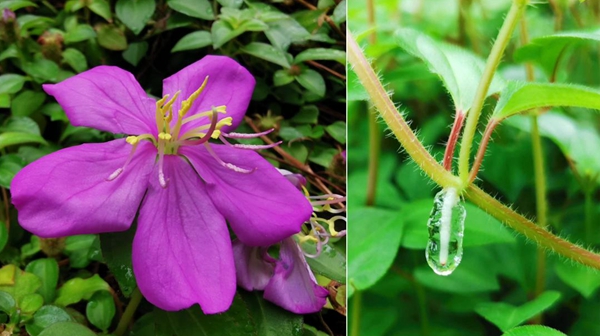Plant-associated microbes play an important role in host nutrient utilization, stress tolerance, plant health, and adaptation.To find out the key mucilage compound and friendly microbe as well as its protective association with diazotrophic microbiota is of great value for understanding the microbial homeostasis of the mucilage-microbiota system.
In a study published in Microbiome, researchers from Xishuangbanna Tropical Botanical Garden (XTBG) and their collaborators investigated the phenomenon of microbiota-mediated nitrogen fixation and elucidated how this process is steadily maintained in the root mucilage microhabitat.
The researchers used pink lady (Heterotis rotundifolia), a fast-growing, perennial shrub, dicotyledon and high-risk invasive plant, to seek the biological function of the aerial root-mucilage system and underlying mechanisms in dicotyledon plants. They also wanted to see how mucilage microhabitat maintained its function and homeostasis in the fluctuant open air.
The researchers compared the biochemical composition of the aerial root mucilage (ARM or mucilage) and underground root exudates (URE) by collecting widely targeted metabolomics data of these samples. They confirmed that aerial root mucilage (ARM) and underground root exudate (URE) had distinct biochemical compositions from each other, both in terms of primary and specialized metabolites
Metabolite and microbiota profiling showed that the aerial root mucilage is enriched in carbohydrates and diazotrophic bacteria. Nitrogen isotope-labeling experiments, 15N natural abundance, and gene expression analysis indicated that the aerial root-mucilage microbiota could fix atmospheric nitrogen to support plant growth. While the aerial root mucilage is a hotspot of nutrients, They did not observe high abundance of other environmental and pathogenic microbes inside.
Moreover, the researchers discovered a friendly fungi, Chaetomella raphigera (F-XTBG8),that has shown broad-spectrum antimicrobial activities, but solely allows the growth of diazotrophic bacteria. It helps mucilage and diazotrophic bacteria withstand pathogenic and environmental microbes.
"This ‘friendly’ fungus may be the key driver to maintain nitrogen fixation function in the mucilage microhabitat. The friendly microbe insight provides important understanding for diverse problems concerning plant microbiota assembly and environmental microbes,” said XU Peng of XTBG.
Contact
XU Peng Ph.D Principal Investigator
Key Laboratory of Tropical Plant Resources and Sustainable Use, Xishuangbanna Tropical Botanical Garden, Chinese Academy of Sciences, Menglun 666303, Yunnan, China
E-mail: xupeng@xtbg.ac.cn

Flower and root mucilage of Heterotis rotundifolia. (Image by PANGZhiqiang)
Published: 21 April 2023

